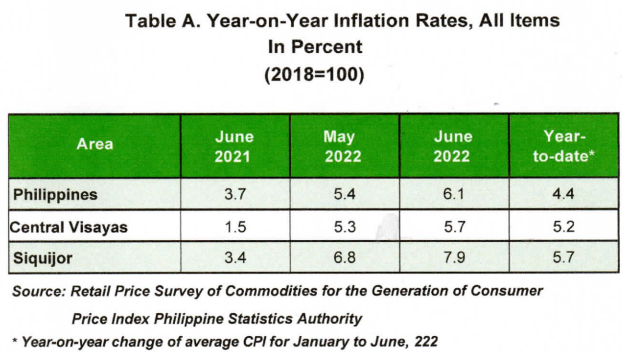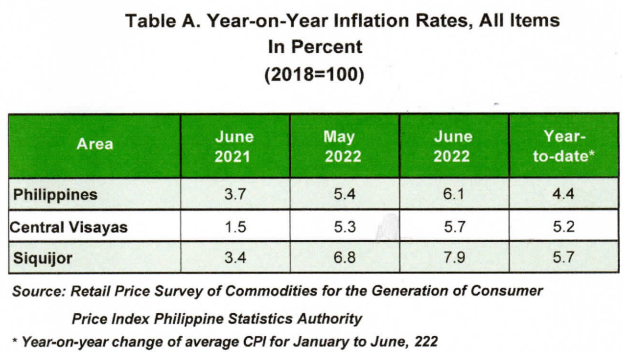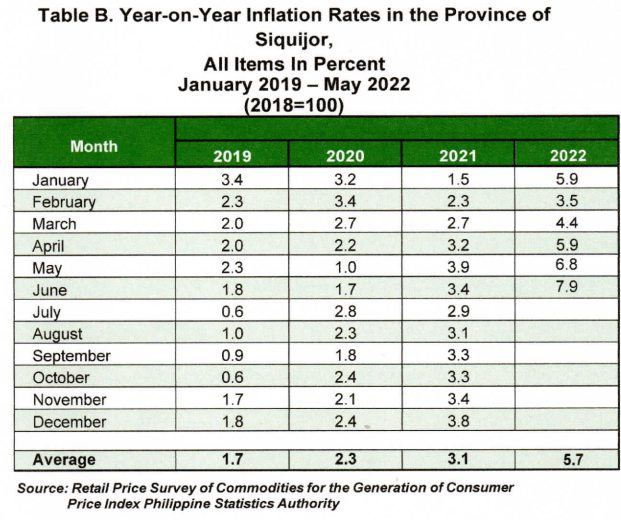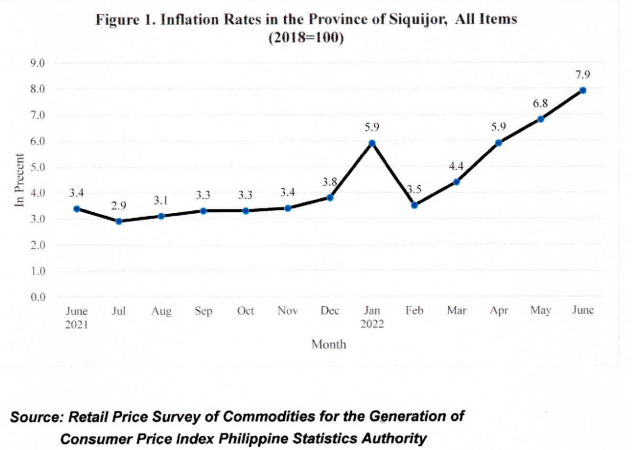Siquijor Province inflation increases by 1.1 percent in June 2022
1. Philippines
The Philippines’ inflation rate increased by 0.7 percent or from 5.4 percent in May 2022 to 6.1 percent in June of 2022. This is the highest inflation recorded since October of 2018. Inflation in June of previous year was lower at 3.7 percent. The average inflation for the first six months of the year stood at 4.4 percent. (see Table A)
June 2022 country’s inflation rate was primarily brought by the higher annual growths in the food and non-alcoholic beverages index at 6.0 percent and transport index at 17.1 percent. On the other hand, June 2022 information and communication index decelerated by 0.5 percent while indices for education services, restaurants and accommodation services, and financial services retained its previous month’s inflation rates.
Moreover, food inflation at the national level rose from 5.2 percent in May 2022 to 6.4 percent in June 2022. This is 2.5 percent higher compared to the June 2021 at 3.5 percent. (see Press Release on CPI for All Income Households for June 2022)
Central Visayas
Inflation rate in Central Visayas increased by 0.4 percent or from 5.3 percent in May of 2022 to 5.7 percent in June of 2022. June of previous year had a lower inflation rate at 1.5 percent. The first six months of the year 2022 posted an average inflation rate of 5.2 percent. (see Table A)

Province of Siquijor
Province of Siquijor recorded an increase of 7.9 percent in June 2022. This is the highest recorded inflation for the province since January of 2019. This was 1.1 percent higher in May 2022 with an inflation of 6.8 percent. The inflation in June of the prior year was lower at 3.4 percent. The province’s average inflation for the first six months of the year registered at 5.7 percent. (see Table A and B and Figure 1)



The higher inflation in the Province of Siquijor was mainly influenced by the following commodity groups:
Furnishings, Household Equipment and Routine Household Maintenance;
Food and non-alcoholic beverage;
Transport;
Clothing and Footwear; and
Health.
On the other hand, Alcohol Beverages and Tobacco; Housing, Water, Electricity, Gas and Other Fuels; and Restaurants and Accommodation Services posted a declined while the following commodities retained its last month’s record:
1. Information and Communication;
2. Recreation, Sport and Culture;
3. Education Services;
4. Financial Services; and
5. Personal Care and Miscellaneous Goods and Services.
TECHNICAL NOTES
Uses of CPI
The CPI is most widely used in the calculation of the inflation rate and purchasing power of peso. It is a major statistical series used for economic analysis and as monitoring indicator of the government economic policy.
Computation of CPI
The computation of CPI involves consideration of the following important points:
a. Base Period – The reference date or base period is the benchmark or reference date or period at which the index is taken as equal to 100.
b. Market Basket – A sample of the thousands of varieties of goods purchased for consumption and the services availed by the households in the country selected to represent the composite price behavior of all goods and services purchased by consumers.
c. Weighting System – The weighting pattern uses the expenditures on various consumer items purchased by households as a proportion to total expenditure.
d. Formula – The formula used in computing the CPI is the weighted arithmetic mean of price relatives, the Laspeyre’s formula with a fixed base year period (2018) weights.
e. Geographic Coverage – CPI values are computed at the national, regional, and provincial levels, and or selected cities.
Inflation Rate is the rate of change of the CPI expressed in percent. See table C for the year on year inflation rate for all items.

